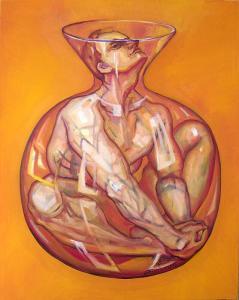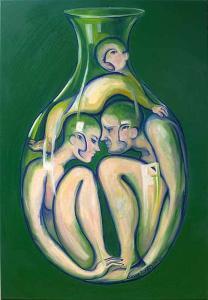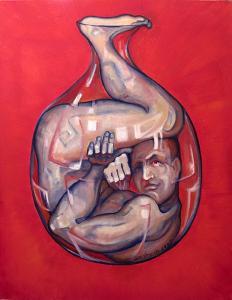“Bottled Ghosts” oil on canvas (English text-see below)
Series of oil paintings “bottled Ghosts”
In Oriental fairy tales a “bottled Ghost” – or “Genie in a Bottle” is a ghost that has been trapped in a bottle for punishment. The mythical genie is duty bound to fulfil his master’s wishes – which he usually does grudgingly tongue in cheek, motivated by the goal of gaining his own freedom.
The paintings of this series take up the idea of the genie in a bottle, transfer ring it in an expressive-realistic style to the situation of modern man, who lives in isolation more or less by own choice. Due to modern age information and communication technology men can get in touch with the entire world in a matter of seconds, but they are varnishing in real contacts and therefore in real interhuman relationships.
Modern men shape their own virtual world and create roles for themselves with adequate functions. Outwardly they seem to be cosmopolitan, active and self-determined, amiable and approachable, but in truth they live in separate closed worlds, tightly fitted to each individual. Each bottled ghost plays his role in this world and experiences the other Fil-tered by their respective role-play. Each lives seeing and visible and yet isolated, encap-sulated, just like a genie in a bottle who derives from another world and is equipped with special talents and therefore can render great services – an escape from this closed world and from the role adjunct to it is impossible. The bottle is magical artefact as well as prison.
Just like the genie, the modern bottled ghost is interested in being appreciated and thereby achieving freedom. In error he chooses the means of deception in order to call attention to himself. This deception must not necessarily be of malicious character, but can simply be an exterior façade, appearances. The mistake is that the mythical genie cannot be freed from his bottle, because as a ghost he simply cannot exist without his bottle. In order to be permanently free from the bottle, the ghost would have to destroy the bottle. At the same time, though, he would deprive himself of his magical powers.
The modern bottled ghost in his turn prevents his own liberation by means of his façade: the appearances of deceit, which are supposed to draw attention, are synonymous with the bottle’s glass. If the ghost escaped from the bottle or broke it, the façade would be gone and the ghost would be even more naked and vulnerable.
Modern man operates behind the protective glass pane and the media, which suggest closeness to him, serve to amplify his solitude. The bottled ghost does not necessarily experience this situation as negative. It all depends from the way the ghost defines his role: constricting and limiting or in extreme concentration on the own person enriching and fulfilling. The transparency of the bottle is essential, because the human being in it is naked and in its nudity conspicuously exposed. There is no option to withdraw, no hiding. The ghost is constantly susceptible to the view, always accessible. The bottle’s protection is an illusion.
Just like a goldfish in a round glass fish tank, the modern bottled ghost can cherish the illusion of unlimited freedom. In combination with adequate self-confidence, this exposed and yet confined situation can be interpreted satisfactorily. The hazy reflection in the glass, though, only allows a vague perception of oneself. No real self-awareness is possi-ble, because the confined conditions don’t allow a real reflection.
For outsiders the modern genie in a bottle seems to exist in a vacuum, which can only be filled by himself and can only be legitimized by the role imposed on the ghost by himself. As long as the genie in a bottle relies on his glass façade and limits interhuman contact to communication filtered and governed by the media, he won’t be able to escape the isola-tion inflicted upon himself by his own choice. If he decides to overcome his fear of losing the “magical abilities” of our modern multimedia society and to destroy his glass façade, the genie will find himself naked and exposed at the mercy of the world, but he has gained innumerable chances for creating his life from scratch with real interhuman rela-tionships.
As many possibilities for a new beginning this enforced “moment of birth” may offer – this new beginning can only be reached by means of a destructive act, which only few people in our day and age dare to face.
Posture and gestures of the bottled ghosts symbolize the various roles of the individual, complementing each other to a panopticon of human existences, whose facets this series tries to present us with.
Kerstin Blum



